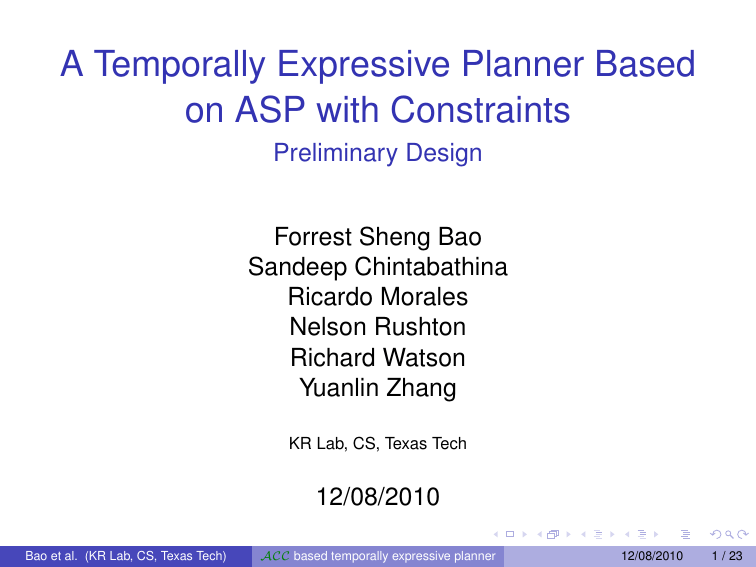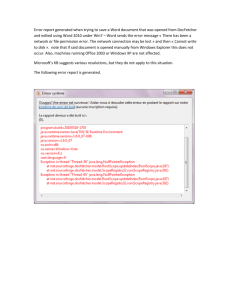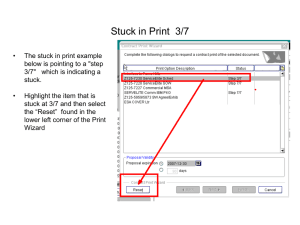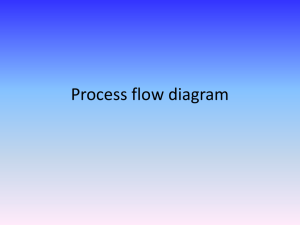A Temporally Expressive Planner Based on ASP with Constraints
advertisement

A Temporally Expressive Planner Based
on ASP with Constraints
Preliminary Design
Forrest Sheng Bao
Sandeep Chintabathina
Ricardo Morales
Nelson Rushton
Richard Watson
Yuanlin Zhang
KR Lab, CS, Texas Tech
12/08/2010
Bao et al. (KR Lab, CS, Texas Tech)
ACC based temporally expressive planner
12/08/2010
1 / 23
A Running Example: The Two-faucet World
Tank 1
Tank 2
faucet 1
faucet 2
Sink
Bao et al. (KR Lab, CS, Texas Tech)
ACC based temporally expressive planner
Vol
12/08/2010
2 / 23
Introduction
Temporally expressive planning requires concurrency
among actions.
Previous approaches cannot handle temporal
expressiveness or cannot handle well.
We try to translate temporally expressive planning problems
in PDDL2.1 into ACC programs and find the plan using ACC
solvers.
Our approach can solve drawbacks of existing other
approaches.
Bao et al. (KR Lab, CS, Texas Tech)
ACC based temporally expressive planner
12/08/2010
3 / 23
1
Introduction
2
An Abstract PDDL Syntax
Building Blocks
Continuous Durative Actions
PDDL Planning Problems
3
Translation from PDDL to ACC
Building Blocks
Continuous Durative Actions
Bao et al. (KR Lab, CS, Texas Tech)
ACC based temporally expressive planner
12/08/2010
4 / 23
Signatures
constants –N
I
I
f 1: faucet 1
f 2: faucet 2
fluents – P
I
I
opened(F ): faucet F is opened.
stuck(F ): faucet F is stuck.
variables – X
I
I
Sink: amount of water in the sink
Tank (F ): amount of water in tank above faucet F
Bao et al. (KR Lab, CS, Texas Tech)
ACC based temporally expressive planner
12/08/2010
5 / 23
Signatures
constants –N
I
I
f 1: faucet 1
f 2: faucet 2
fluents – P
I
I
opened(F ): faucet F is opened.
stuck(F ): faucet F is stuck.
variables – X
I
I
Sink: amount of water in the sink
Tank (F ): amount of water in tank above faucet F
Bao et al. (KR Lab, CS, Texas Tech)
ACC based temporally expressive planner
12/08/2010
5 / 23
Signatures
constants –N
I
I
f 1: faucet 1
f 2: faucet 2
fluents – P
I
I
opened(F ): faucet F is opened.
stuck(F ): faucet F is stuck.
variables – X
I
I
Sink: amount of water in the sink
Tank (F ): amount of water in tank above faucet F
Bao et al. (KR Lab, CS, Texas Tech)
ACC based temporally expressive planner
12/08/2010
5 / 23
1
Introduction
2
An Abstract PDDL Syntax
Building Blocks
Continuous Durative Actions
PDDL Planning Problems
3
Translation from PDDL to ACC
Building Blocks
Continuous Durative Actions
Bao et al. (KR Lab, CS, Texas Tech)
ACC based temporally expressive planner
12/08/2010
6 / 23
Continuous Durative Actions
Example (a durative action)
h open(F ),
h?duration ≤ Tank (F )/flowRate(F )i,
h ¬opened(F ) ∧ ¬stuck(F ),
Tank(F ) > 0,
¬stuck (F ) ∧ opened(F )
i,
h opened(F ),
Sink increase flowRate(F ) ∗ ∆t ∧
Tank (F ) decrease flowRate(F ) ∗ ∆t,
¬opened(F )
i
i
Bao et al. (KR Lab, CS, Texas Tech)
ACC based temporally expressive planner
12/08/2010
7 / 23
Continuous Durative Actions
Example (a durative action)
h open(F ),
h?duration ≤ Tank (F )/flowRate(F )i,
h ¬opened(F ) ∧ ¬stuck (F ),
Tank(F ) > 0,
¬stuck (F ) ∧ opened(F )
i,
h opened(F ),
Sink increase flowRate(F ) ∗ ∆t ∧
Tank (F ) decrease flowRate(F ) ∗ ∆t,
¬opened(F )
i
i
Bao et al. (KR Lab, CS, Texas Tech)
ACC based temporally expressive planner
12/08/2010
7 / 23
Continuous Durative Actions
Example (a durative action)
h open(F ),
h?duration ≤ Tank (F )/flowRate(F )i,
h ¬opened(F ) ∧ ¬stuck (F ),
Tank(F ) > 0,
¬stuck (F ) ∧ opened(F )
i,
h opened(F ),
Sink increase flowRate(F ) ∗ ∆t ∧
Tank (F ) decrease flowRate(F ) ∗ ∆t,
¬opened(F )
i
i
Bao et al. (KR Lab, CS, Texas Tech)
ACC based temporally expressive planner
12/08/2010
7 / 23
Continuous Durative Actions
Example (a durative action)
h open(F ),
h?duration ≤ Tank (F )/flowRate(F )i,
h ¬opened(F ) ∧ ¬stuck (F ),
Tank(F ) > 0,
¬stuck (F ) ∧ opened(F )
i,
h opened(F ),
Sink increase flowRate(F ) ∗ ∆t ∧
Tank (F ) decrease flowRate(F ) ∗ ∆t,
¬opened(F )
i
i
Bao et al. (KR Lab, CS, Texas Tech)
ACC based temporally expressive planner
12/08/2010
7 / 23
Continuous Durative Actions
Example (a durative action)
h open(F ),
h?duration ≤ Tank (F )/flowRate(F )i,
h ¬opened(F ) ∧ ¬stuck (F ),
Tank(F ) > 0,
¬stuck (F ) ∧ opened(F )
i,
h opened(F ),
Sink increase flowRate(F ) ∗ ∆t ∧
Tank (F ) decrease flowRate(F ) ∗ ∆t,
¬opened(F )
i
i
Bao et al. (KR Lab, CS, Texas Tech)
ACC based temporally expressive planner
12/08/2010
7 / 23
Continuous Durative Actions
Example (a durative action)
h open(F ),
h?duration ≤ Tank (F )/flowRate(F )i,
h ¬opened(F ) ∧ ¬stuck (F ),
Tank(F ) > 0,
¬stuck (F ) ∧ opened(F )
i,
h opened(F ),
Sink increase flowRate(F ) ∗ ∆t ∧
Tank (F ) decrease flowRate(F ) ∗ ∆t,
¬opened(F )
i
i
Bao et al. (KR Lab, CS, Texas Tech)
ACC based temporally expressive planner
12/08/2010
7 / 23
Continuous Durative Actions
Example (a durative action)
h open(F ),
h?duration ≤ Tank (F )/flowRate(F )i,
h ¬opened(F ) ∧ ¬stuck (F ),
Tank(F ) > 0,
¬stuck (F ) ∧ opened(F )
i,
h opened(F ),
Sink increase flowRate(F ) ∗ ∆t ∧
Tank (F ) decrease flowRate(F ) ∗ ∆t,
¬opened(F )
i
i
Bao et al. (KR Lab, CS, Texas Tech)
ACC based temporally expressive planner
12/08/2010
7 / 23
Continuous Durative Actions
Example (a durative action)
h open(F ),
h?duration ≤ Tank (F )/flowRate(F )i,
h ¬opened(F ) ∧ ¬stuck (F ),
Tank(F ) > 0,
¬stuck (F ) ∧ opened(F )
i,
h opened(F ),
Sink increase flowRate(F ) ∗ ∆t ∧
Tank (F ) decrease flowRate(F ) ∗ ∆t,
¬opened(F )
i
i
Bao et al. (KR Lab, CS, Texas Tech)
ACC based temporally expressive planner
12/08/2010
7 / 23
1
Introduction
2
An Abstract PDDL Syntax
Building Blocks
Continuous Durative Actions
PDDL Planning Problems
3
Translation from PDDL to ACC
Building Blocks
Continuous Durative Actions
Bao et al. (KR Lab, CS, Texas Tech)
ACC based temporally expressive planner
12/08/2010
8 / 23
PDDL Planning Problems
A PDDL planning problem consists of:
A set of actions.
An initial state, a conjunction of ground fluents and numeric
constraints
Example (An initial state)
{Sink = 0, Tank(f 1, 0) = 5, Tank(f , 0) = 5, ¬opened(f 1),
¬opened(f 2), ¬stuck (f 1), ¬stuck(f 2), flowRate(f 1) = 2,
flowRate(f 2) = 3}
A goal state, a conjunction of ground fluents and numeric
constraints.
Example (A goal state)
{Sink = 5}
Bao et al. (KR Lab, CS, Texas Tech)
ACC based temporally expressive planner
12/08/2010
9 / 23
PDDL Planning Problems
A PDDL planning problem consists of:
A set of actions.
An initial state, a conjunction of ground fluents and numeric
constraints
Example (An initial state)
{Sink = 0, Tank(f 1, 0) = 5, Tank(f , 0) = 5, ¬opened(f 1),
¬opened(f 2), ¬stuck (f 1), ¬stuck(f 2), flowRate(f 1) = 2,
flowRate(f 2) = 3}
A goal state, a conjunction of ground fluents and numeric
constraints.
Example (A goal state)
{Sink = 5}
Bao et al. (KR Lab, CS, Texas Tech)
ACC based temporally expressive planner
12/08/2010
9 / 23
PDDL Planning Problems
A PDDL planning problem consists of:
A set of actions.
An initial state, a conjunction of ground fluents and numeric
constraints
Example (An initial state)
{Sink = 0, Tank(f 1, 0) = 5, Tank(f , 0) = 5, ¬opened(f 1),
¬opened(f 2), ¬stuck (f 1), ¬stuck(f 2), flowRate(f 1) = 2,
flowRate(f 2) = 3}
A goal state, a conjunction of ground fluents and numeric
constraints.
Example (A goal state)
{Sink = 5}
Bao et al. (KR Lab, CS, Texas Tech)
ACC based temporally expressive planner
12/08/2010
9 / 23
Plans
A plan is a set of timed pairs of either the form (t, a[t 0 ]) or
(t, a) where t is a time, a an action name and t 0 a time
specifying the duration of a durative action.
A valid plan for “two-faucet” example is
h(0, open(f 1)[1]), (0, open(f 2)[1])i.
Bao et al. (KR Lab, CS, Texas Tech)
ACC based temporally expressive planner
12/08/2010
10 / 23
Plans
A plan is a set of timed pairs of either the form (t, a[t 0 ]) or
(t, a) where t is a time, a an action name and t 0 a time
specifying the duration of a durative action.
A valid plan for “two-faucet” example is
h(0, open(f 1)[1]), (0, open(f 2)[1])i.
Bao et al. (KR Lab, CS, Texas Tech)
ACC based temporally expressive planner
12/08/2010
10 / 23
1
Introduction
2
An Abstract PDDL Syntax
Building Blocks
Continuous Durative Actions
PDDL Planning Problems
3
Translation from PDDL to ACC
Building Blocks
Continuous Durative Actions
Bao et al. (KR Lab, CS, Texas Tech)
ACC based temporally expressive planner
12/08/2010
11 / 23
Predicates
Example (Predicates for the “two-faucet” world)
opened(F ) =⇒ opened(F , S)
stuck (F ) =⇒ stuck (F , S)
(introduced) =⇒ occurs(A, S)
More will be added later.
Bao et al. (KR Lab, CS, Texas Tech)
ACC based temporally expressive planner
12/08/2010
12 / 23
Numeric Variables and Functions
Example (Functions for the “two-faucet” world)
Sink =⇒ Sink(S) ∈ R
Tank(F ) =⇒ Tank(F , S) ∈ R
(introduced) =⇒ at(S) ∈ the domain of time
More will be added later.
Bao et al. (KR Lab, CS, Texas Tech)
ACC based temporally expressive planner
12/08/2010
13 / 23
Initial States
Example (A set of facts representing an initial state)
¬opened(f 1, 0).
¬opened(f 2, 0).
¬stuck (f 1, 0).
¬stuck (f 2, 0).
Sink(0) = 0.
Tank(f 1, 0) = 5.
Tank(f 2, 0) = 5.
Bao et al. (KR Lab, CS, Texas Tech)
ACC based temporally expressive planner
12/08/2010
14 / 23
Goal States
Example (A set of rules representing a goal state)
goal ← Sink(S) = 5.
← not goal.
Bao et al. (KR Lab, CS, Texas Tech)
ACC based temporally expressive planner
12/08/2010
15 / 23
1
Introduction
2
An Abstract PDDL Syntax
Building Blocks
Continuous Durative Actions
PDDL Planning Problems
3
Translation from PDDL to ACC
Building Blocks
Continuous Durative Actions
Bao et al. (KR Lab, CS, Texas Tech)
ACC based temporally expressive planner
12/08/2010
16 / 23
Divide and Conquer
Original action
h open(F ),
h?duration ≤ tank(F )/flowRate(F )i,
h ¬opened(F ) ∧ ¬stuck (F ),
Tank (F ) > 0,
¬stuck (F ) ∧ opened(F )
i,
h opened(F ),
Sink increase flowRate(F ) ∗ ∆t ∧
Tank(F ) decrease flowRate(F ) ∗ ∆t,
¬opened(F )
i
i
Now it becomes
A new action for “at start”:
h opens (F ),
¬opened(F ) ∧ ¬stuck(F ),
opened(F )i
and a new action for “at end”:
h opene (F ),
¬stuck(F ) ∧ opened(F ),
¬opened(F )i
Later we will discuss about invariant monitoring and constinuous
assignment.
Bao et al. (KR Lab, CS, Texas Tech)
ACC based temporally expressive planner
12/08/2010
17 / 23
Divide and Conquer
Original action
h open(F ),
h?duration ≤ tank(F )/flowRate(F )i,
h ¬opened(F ) ∧ ¬stuck (F ),
Tank (F ) > 0,
¬stuck (F ) ∧ opened(F )
i,
h opened(F ),
Sink increase flowRate(F ) ∗ ∆t ∧
Tank(F ) decrease flowRate(F ) ∗ ∆t,
¬opened(F )
i
i
Now it becomes
A new action for “at start”:
h opens (F ),
¬opened(F ) ∧ ¬stuck(F ),
opened(F )i
and a new action for “at end”:
h opene (F ),
¬stuck(F ) ∧ opened(F ),
¬opened(F )i
Later we will discuss about invariant monitoring and constinuous
assignment.
Bao et al. (KR Lab, CS, Texas Tech)
ACC based temporally expressive planner
12/08/2010
17 / 23
Divide and Conquer
Original action
h open(F ),
h?duration ≤ tank(F )/flowRate(F )i,
h ¬opened(F ) ∧ ¬stuck (F ),
Tank (F ) > 0,
¬stuck (F ) ∧ opened(F )
i,
h opened(F ),
Sink increase flowRate(F ) ∗ ∆t ∧
Tank(F ) decrease flowRate(F ) ∗ ∆t,
¬opened(F )
i
i
Now it becomes
A new action for “at start”:
h opens (F ),
¬opened(F ) ∧ ¬stuck(F ),
opened(F )i
and a new action for “at end”:
h opene (F ),
¬stuck(F ) ∧ opened(F ),
¬opened(F )i
Later we will discuss about invariant monitoring and constinuous
assignment.
Bao et al. (KR Lab, CS, Texas Tech)
ACC based temporally expressive planner
12/08/2010
17 / 23
Divide and Conquer
Original action
h open(F ),
h?duration ≤ tank(F )/flowRate(F )i,
h ¬opened(F ) ∧ ¬stuck (F ),
Tank (F ) > 0,
¬stuck (F ) ∧ opened(F )
i,
h opened(F ),
Sink increase flowRate(F ) ∗ ∆t ∧
Tank(F ) decrease flowRate(F ) ∗ ∆t,
¬opened(F )
i
i
Now it becomes
A new action for “at start”:
h opens (F ),
¬opened(F ) ∧ ¬stuck(F ),
opened(F )i
and a new action for “at end”:
h opene (F ),
¬stuck(F ) ∧ opened(F ),
¬opened(F )i
Later we will discuss about invariant monitoring and constinuous
assignment.
Bao et al. (KR Lab, CS, Texas Tech)
ACC based temporally expressive planner
12/08/2010
17 / 23
Precondition Satisfaction
Example (Encoding preconditions for opens (F ))
← opens (F , S), not ¬stuck(F , S).
← opens (F , S), not ¬opened(F , S).
Basic idea: If a precondition is not known as satisfied, then the
action cannot execute.
Bao et al. (KR Lab, CS, Texas Tech)
ACC based temporally expressive planner
12/08/2010
18 / 23
Effects on Fluents of Simple Actions
Example (Encoding Effects on Fluents for opene (F ))
¬opened(F , S + 1) ← occurs(opene (F ), S)
opened(F , S + 1) ← opened(F , S), not ¬opened(F , S + 1)
¬opened(F , S + 1) ← ¬opened(F , S), not opened(F , S + 1)
Bao et al. (KR Lab, CS, Texas Tech)
ACC based temporally expressive planner
12/08/2010
19 / 23
Continuous Variable Assignment I
1
2
Introduce a new predicate action on(A, S) to mark whether
action S is on at step S.
We then introduce a function delta.
Example (Contribution of each action to Sink(S))
delta(Sink (S), open(F ), S, T ) =
←
delta(Sink (S), open(F ), S, T ) =
←
Bao et al. (KR Lab, CS, Texas Tech)
flowRate(F ) ∗ T
action on(open(F ), S).
0
not action on(open(F ), S).
ACC based temporally expressive planner
12/08/2010
20 / 23
Continuous Variable Assignment II
3
Finally, we introduce a function f to sum up the contribution
of actions on variables
Example (Summing up contribution on Sink(S))
f (Sink(S), T ) =
+
+
←
Bao et al. (KR Lab, CS, Texas Tech)
Sink(S)
delta(Sink(S), open(f 1), S, T )
delta(Sink (S), open(f 2), S, T )
at(S + 1) = T 1, at(S) = T 0,
0 ≤ T ≤ T 1 − T 0.
ACC based temporally expressive planner
12/08/2010
21 / 23
Invariant Monitoring
Example (Invariant Monitoring for open(S) action)
violated(open(F ), Ss, Se) ← duration(open(F ), Ss, Se),
at(S) = T 1, at(S + 1) = T 2,
Ss ≤ S ≤ Se, T 1 ≤ T ≤ T 2,
f (Tank (F ), S, T − T 1) = X ,
not (X > 0).
← violated(open(F ), Ss, Se).
Bao et al. (KR Lab, CS, Texas Tech)
ACC based temporally expressive planner
12/08/2010
22 / 23
Potluck
What time?
What food?
Bao et al. (KR Lab, CS, Texas Tech)
ACC based temporally expressive planner
12/08/2010
23 / 23





